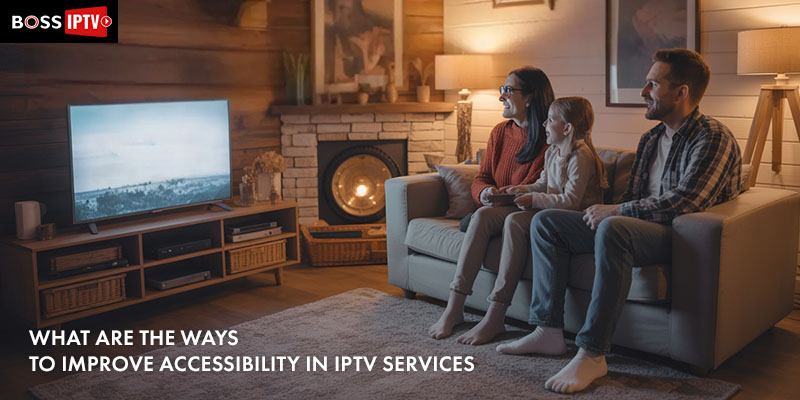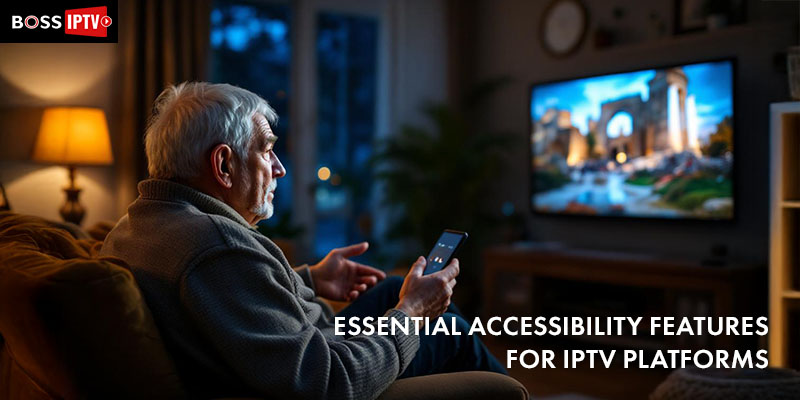
In today’s fast-changing streaming world, IPTV services have completely transformed the way we enjoy entertainment. With more than 1.5 billion people worldwide living with some form of disability, the need for accessible streaming options has never been more important. As IPTV in the USA continues to grow and more consumers look for the best IPTV service, providers are realizing that accessibility isn’t just about meeting legal standards — it’s a smart way to stand out from the competition.
Whether you’re a service provider aiming to reach a wider audience or a viewer searching for an inclusive IPTV subscription, understanding the key accessibility features in IPTV apps can make all the difference between a frustrating experience and smooth, enjoyable entertainment. This guide shares practical strategies to improve IPTV accessibility, helping ensure that everyone can enjoy high-quality streaming no matter their abilities.
When it comes to choosing the best IPTV service, accessibility is often what truly sets a platform apart. While traditional TV broadcasting has long offered features like closed captioning and audio descriptions, IPTV services face their own unique challenges in providing these features reliably across different devices and apps.
Users with visual, hearing, motor, or cognitive disabilities often run into specific obstacles when using IPTV platforms. These can include limited subtitle options, confusing navigation, or a lack of support for assistive technologies. Recognizing and addressing these barriers is an essential first step toward making IPTV experiences more inclusive and accessible for everyone.

Comprehensive captioning options that do more than just provide basic subtitles should be available from any reliable IPTV provider. Speaker identification, sound effect descriptions, and precise timing to guarantee flawless synchronization with the content are all characteristics of high-quality closed captions. Prominent IPTV service providers ensure that their captions maintain a consistent, comprehensible format and function flawlessly on all supported devices.
Advanced captioning features should also let users change the background opacity, fonts, colours, and text size for a truly inclusive experience. By allowing viewers to customize captions to suit their own visual requirements and tastes, these options improve accessibility and comfort for all viewers.
Audio descriptions are narrated explanations of visual elements in a video, played during natural pauses in dialogue. They’re essential for making video content accessible to users with visual impairments. Top IPTV providers include secondary audio programs (SAP) channels that deliver these descriptions without disrupting the main audio track.
When choosing an IPTV subscription, it’s important to look for providers that offer audio descriptions across a wide range of content—not just a few select programs. The best services provide descriptions for movies, TV shows, documentaries, and even some live broadcasts, ensuring a more inclusive viewing experience for everyone.
To promote visual accessibility, modern IPTV providers should focus on offering comprehensive display customization options. Key features include a high contrast mode within the app settings, allowing users to adjust text size, background colors, and brightness levels to suit their individual needs. Including clear, intuitive icons and larger buttons throughout the interface also helps improve usability for users with visual impairments.
Ensuring compatibility with screen readers is equally important, as it allows users with severe visual impairments to navigate the platform using assistive technologies. This involves using proper semantic markup and providing alternative text descriptions for all visual elements within the app, making the platform more accessible to everyone.
Language barriers can greatly limit access for non-native speakers and immigrant communities, making it harder for them to fully enjoy IPTV platforms and find content that reflects their cultural background
To enhance accessibility, IPTV providers should offer multilingual interfaces and ensure navigation, settings, and help resources are available in users’ preferred languages. Using advanced tagging to organize content by language, genre, and region makes it easier to find relevant programs. In markets like the USA, dedicated Indian regional categories for languages like Hindi, Tamil, Malayalam, Marathi, Gujarati and more help users discover their regional content. The aim is to provide a seamless experience that allows users to enjoy content in their native language while exploring diverse cultural programs worldwide.
In today’s fast-moving digital world, people want the freedom to watch their favorite content anytime, anywhere, and on any device. A mobile-friendly IPTV service makes it easy for users to stream live TV, movies, or on-demand shows seamlessly across smartphones, tablets, laptops, and smart TVs. As more viewers turn to mobile devices for entertainment, optimizing your IPTV app for both iOS and Android is crucial. Features like a responsive design, simple navigation, and smooth streaming across different screen sizes not only improve the user experience but also make your service accessible to a wide range of users with different needs and preferences.
Supporting multiple devices also means providing a consistent experience whether someone is casting content from their phone to a smart TV or switching from a laptop to a tablet. The best IPTV services should support popular casting technologies. This kind of flexibility not only adds convenience but also helps your service stay competitive in a crowded market. By prioritizing mobile compatibility and multi-device support, IPTV providers can better retain users and deliver a truly modern, enjoyable viewing experience.
Creating accessible IPTV services takes dedication, resources, and ongoing effort, but the rewards go beyond just meeting regulations. It opens up new markets, boosts your brand’s reputation, and ensures everyone can enjoy entertainment. Top IPTV providers see accessibility as a vital part of delivering quality service, not just an extra feature.
The future of TV is inclusive, and forward-thinking providers are already making it happen.
A: Apps that offer screen reader compatibility, voice navigation, and closed captions are typically considered the most accessible. Look for apps that support mobile and smart TVs with simplified user interfaces.
A: Yes, several IPTV providers in the USA now offer accessibility features such as subtitles, high-contrast modes, and multilingual support.
A: Always check the provider’s feature list or contact customer support. Many top providers highlight accessibility under their service description.
Fill the form to get instant access!